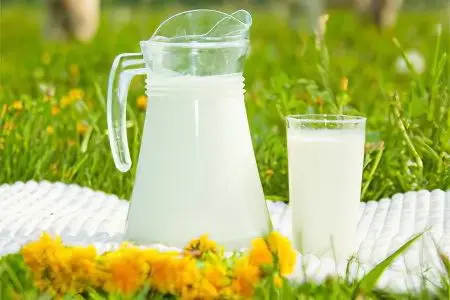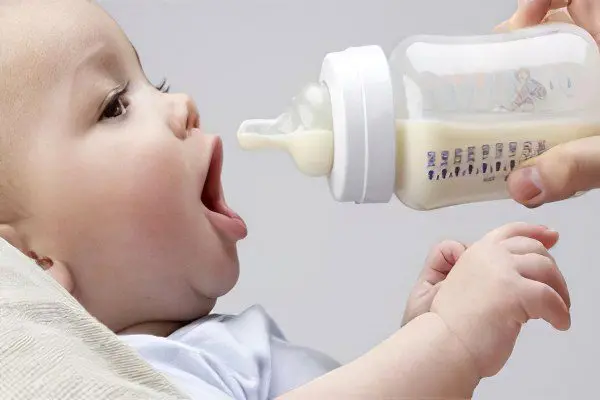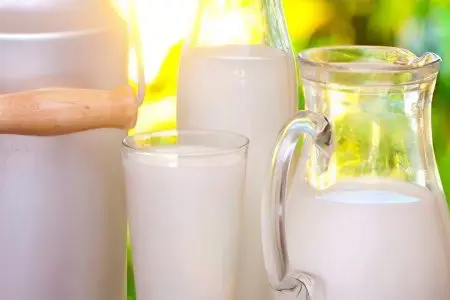Contents
- Is it possible to cow’s milk for children under one year old?
- How is goat’s milk different from cow’s and mother’s milk?
- Can a breastfeeding mother drink milk?
- Goat milk for children under one year old
- Is milk possible for children after a year?
- What kind of milk is best for children?
- Diseases transmitted to humans through the use of fresh (not boiled) milk
- And a few more facts
- Conclusions!

After nine months of intrauterine life, the child, being born, finds himself in conditions that are absolutely new for him, incomprehensible and unusual. It is very similar to the state of weightlessness. The baby needs to learn to adapt, breathe, move and eat.
Mother’s milk is the first product that the baby meets and eats. In the first year of life, it is very important to establish feeding, the health of the child, his further growth and development depends on this. Breastfeeding is the main factor in the adaptation of children in a new world for them. Mother’s milk is unique by nature and ideal for a child, it is the best option for baby food, the surest way to health and full development. A worthy replacement for breast milk has not yet been invented.
Unfortunately, not all women have the opportunity, and sometimes the desire to accustom a child to the breast. In such cases, you have to resort to additional power sources. Their choice can be a big problem for inexperienced mothers. What kind of milk can be given, and what is better to refuse? Are dairy products dangerous for babies and at what age is it recommended to give milk to a child? Let’s try to understand the issues that are likely to concern both expectant mothers and those who already know the joys of motherhood.
Is it possible to cow’s milk for children under one year old?
The most common of the fears of young mothers are endless fears that the child is malnourished and remains hungry due to a lack of breast milk. Then the question arises, what to feed and how to diversify the diet of the baby. Mistakes in nutrition must be excluded, in the first year of a child’s life this is especially important. We hasten to reassure mothers who are breastfeeding. If the feeding goes well, the baby does not need additional nutrition, he always has enough of everything, he is full and satisfied.
Until now, the effect of cow’s milk on the body of babies up to a year and older has not been fully studied, but certain conclusions have been drawn. Pediatricians claim that animal milk for young children is an unadapted product. A cow is a herbivore, while a person has a meat type of nutrition at the genetic level. It turns out that in humans and cows, the set of amino acids and the composition of milk are completely different.
Together with milk, hormones, microelements and cattle antibodies enter the human body. And it does not matter what kind of milk it is, camel or cow, deer or goat. Scientists are very concerned about the consequences of this hormonal effect on the body of young children. Hormones in the milk of animals stimulate earlier sexual development and the increase in cancerous tumors in the future. The harmful effects are not limited to this. Consider all aspects of the effect of cow’s milk on the health of young children.
Chemical composition and properties of cow’s milk
Cow’s milk is a huge supply of macro and micronutrients. The content of these components is several times higher than the composition of breast milk. In this case, an excess of components can be considered a disadvantage, it can be dangerous. For a child, this is an extra ballast. The load on the kidneys and excretory system exceeds the permissible values by almost 5 times.
There is very little iron in milk, but even it is not absorbed, as it belongs to the heme type.
Children in the first year of life develop very actively, and iron deficiency can cause iron deficiency anemia.
In the composition of cow’s milk, there are almost no components that can strengthen the immune system. It is low in carbohydrates, zinc, vitamin C.
Lack of essential enzymes in an infant
Enzymes intended for the assimilation of cow’s milk are not produced in the gastrointestinal tract of the baby. The body spends too much energy on the breakdown of foreign amino acids, and this is also a double load. Diarrhea is a normal reaction of the body to this process. There are no such problems with mother’s milk, it is perfectly absorbed and provides the body with all the necessary components.
Aggressive effect of cow’s milk protein
The protein in milk is casein. Its aggressive effect on the intestines of the child leads to an excess of histamine levels, which causes allergic reactions. In addition, the intestinal walls are injured, hemoglobin begins to fall, and iron deficiency anemia develops.
High risk of allergies
Even if allergic reactions did not occur in infancy, in the future the child is not immune from their appearance. Allergy develops and does not act immediately, accumulating, it can declare itself at any time. Allergies can start suddenly and violently. Defense mechanisms may not be able to cope with complications. Dairy products are safer in this respect.
How is goat’s milk different from cow’s and mother’s milk?

Foreign proteins in goat’s and cow’s milk. The proteins contained in a woman’s breast milk are involved in the construction of new cells. The proteins in animal milk are foreign. For their assimilation, the body spends too much energy; for a child, this is a heavy product.
Goat milk has more fat. This contributes to the buildup of subcutaneous adipose tissue. If a baby is found to be underweight, this is not bad, in other cases it is harmful.
Goat’s milk has fewer carbohydrates than cow’s milk. For a child with lactose deficiency, this is good, the usefulness of this property is manifested only after reaching 2-3 years of age.
Goat milk contains more vitamins and minerals than cow milk. For the product, this is an advantage, but it loses its meaning, since almost all vitamins die during the boiling or pasteurization process.
More calcium and phosphorus than cow’s. The presence of these components enhances
musculoskeletal system. This is a good prevention of diseases such as caries and rickets, however, without vitamin D, calcium is poorly absorbed, and an excess of phosphorus, on the contrary, is quickly absorbed. The load on the kidneys increases markedly, and this is a direct path to urolithic pathologies. The kidneys of the child are finally formed by the age of three, at this age it is possible to give milk within reasonable limits. The norm is no more than one glass a day.
Can a breastfeeding mother drink milk?
The debate over whether a breastfeeding woman can drink animal milk has been going on for decades. Medical scientists have reached agreement on the issue of the first month of feeding. During this period, drinking milk is not recommended, here the opinions agreed.
Further controversy:
Some believe that regular consumption of milk during the feeding period is harmless, moreover, large reserves of calcium are useful for the baby, in particular, for the formation of bone tissue.
Some are convinced that milk in the diet of a breastfeeding mother can cause intestinal pain and colic in the child, so it is recommended to use sour-milk products.
And yet, most doctors tend to moderation and extreme caution. Milk can be added to tea and porridge, it is better to refuse whole milk. Do not abuse and with quantity, excessiveness is inappropriate.
Initially, animal milk is intended for feeding born cubs. Its task is to increase the weight and volume of muscle mass. A woman’s breast milk has a different purpose. Man is a completely different biological type, breastfeeding, first of all, provides the brain of a small child with polyunsaturated fats, so animal milk will never replace mother’s milk.
Goat milk for children under one year old
Some parents believe that goat’s milk is healthier and better than cow’s. This is a misconception, since there are even more vitamins and minerals in goat’s milk.
At an early age, the immature organs of the child’s excretory system experience a tremendous load on the absorption of goat’s milk, which is extremely undesirable for an actively developing organism.
Goat milk contains triglycerides and casein, their negative effect on the body is always noticeable. Any milk, interacting with gastric juice, coagulates. Casein milk is poorly digested, it turns into clots that a small unformed stomach is not able to cope with.
Anemia is the most serious consequence of the use of goat’s milk when feeding a child.
In the absence of other food sources, megaloblastic anemia can develop. Irreversible processes will begin in the body, which can lead to disruption of the work of all vital organs. (List of foods to increase hemoglobin)
Is milk possible for children after a year?

Observe reasonable limits – this is how the main rule can be indicated when introducing animal milk into the diet of a child after a year. Start with a small amount, cook porridge with milk and watch the reaction. It is very important to be aware of the signs of an allergy and to react in a timely manner to its manifestation.
By the way, the preparation of milk porridge requires knowledge of certain nuances. Due to the high calorie content, such cereals can harm health. For children’s dishes, milk is recommended to be diluted, for 150 ml of milk 90 ml of water. If a child has a hereditary tendency to overweight, porridge is boiled without milk, just on water.
As for the age when you can safely give milk to a child, everything is individual here. The main thing to remember is that the enzymes necessary for the breakdown of milk appear in the body after reaching two years. Until then, it is better not to risk it, and if breastfeeding is not possible, use high-quality milk formulas.
Accuracy and attention will be required when introducing milk into baby food and at a later age. In the absence of allergies and normal stools, milk can be given, but within reasonable limits and preferably diluted.
What kind of milk is best for children?
The benefits of milk during pasteurization are not lost, only pathogens are killed, but pasteurized milk can be dangerous, especially for young children with an immature digestive system. To save animals from epidemics, they are injected with animal antibiotics. In America and most European countries, this is prohibited, there are very strict standards and farmers comply with them. In our country the situation is different. Antibiotics enter the body of animals, and together with milk and into the human body.
Useful qualities of pasteurized milk are also deprived of synthetic hormones. They are used to improve productivity on dairy farms. Cows are given special drugs that increase milk yield. This gives results, the volumes of milk really grow, however, the mammary glands of a cow are not always ready for this. Inflammatory processes begin, requiring surgical treatment of animals.
Raw milk can also be dangerous. Domestic cows are not always properly cared for. No one will confirm the cleanliness of the hostess and the absence of diseases in the animal. Sanitary control is often not carried out, there are infections and diseases that can occur without symptoms. It turns out that if a cow is sick, it is difficult to determine.
Diseases transmitted to humans through the use of fresh (not boiled) milk
Many have heard about the miraculous properties of fresh milk. It is unique in composition and contains almost all the nutritional properties necessary for a person. In our case, when it comes to young children, all risks must be eliminated. Fresh milk is obtained in the same way, cows are milked at home or on farms. Violation of sanitary and hygienic standards is not excluded, therefore, no matter how wonderful fresh milk may be, it is impossible to give it to children in unboiled form.
Fresh milk provokes the development of a number of serious, life-threatening diseases:
Leukemia;
Youth;
Tuberculosis;
Anthrax;
Gastroenteritis;
Q fever;
Brucellosis;
Tick-borne encephalitis;
And a few more facts

There are many interesting pages in the history of breastfeeding. Once upon a time, women who did not have the opportunity or desire to breastfeed turned to nurses. In the 18th century, skinny young ladies, pulled into corsets, did not want to feed their own children. The environment required compliance with strict fashion standards regarding behavior in society and appearance. Under these conditions, in addition to the services of nurses, another alternative was found, children began to be fed with cow’s milk. For a long time it was actively used in baby food, but in our time, priorities and attitudes towards animal milk have changed. Doctors are no longer so friendly to this product and loudly declare possible risks and consequences.
About the potential harm of milk for children and adults
Scientists from Harvard University have found a link between excessive consumption of milk and the development of cancer. In women, breast and ovarian cancer; in men, prostate cancer.
The opinion about the preventive benefits of milk in osteoporosis has been refuted. The destruction of bone tissue in adulthood cannot be prevented by diets based on daily consumption of dairy products. Excess calcium in the composition of milk does not strengthen bone tissue. This statement was made by American scientists in the course of a study involving more than 75 thousand people. Among the subjects were women, they were observed for 12 years. As a result, it turned out that regular consumption of milk with a gradual increase in quantity does not have a protective effect. Moreover, bone fragility is markedly increased.
A promising study that three times a day milk intake reduces weight has also not been confirmed. Those dreaming of losing weight have lost hope of losing weight using an affordable and reliable product. It turned out that milk is powerless in the fight against fat, no matter how much you drink, the result will be zero.
In the early 60s, milk was introduced into the school menu in Japan. Over the past 30 years, the number of patients with hay fever and dermatitis has increased markedly in this country. Some scientists attribute this outbreak to milk, the oxidized fats in its composition lead to the multiplication of harmful bacteria and destroy the intestinal microflora.
Conclusions!
Future and already established mothers should know that their milk is exactly what the child needs. The composition and properties of mother’s milk change with the age of the baby, depending on the diet, time of day, psychological state. It seems to adapt to the situation and gives what is necessary for normal life. Of great importance is the emotional contact of the child with the mother. From childhood, the baby feels closeness, security and trust. This state persists for life and affects further adaptation and development.
If breastfeeding is not possible for some reason, use adapted milk-based formulas. There is less protein in them, there are no extra minerals, they do not pose a danger. When choosing artificial mixtures, the state of health and physical development of the child is taken into account. You can’t do without a pediatrician in this matter, only a doctor can choose the best option for a milk formula and give the necessary recommendations.









